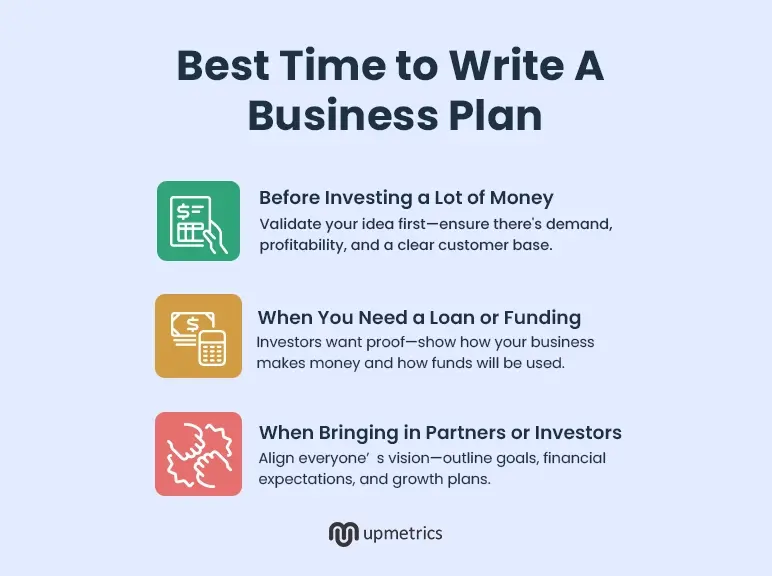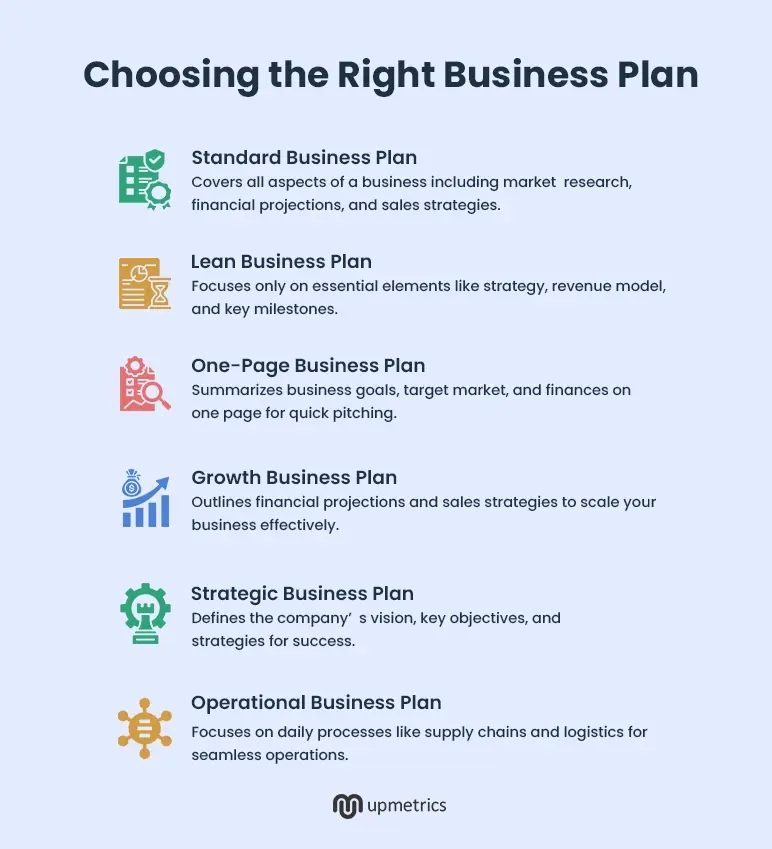Every successful business starts with an idea.
As Scott Belsky, the Chief Strategy Officer and Executive Vice President at Adobe, said—“It’s not about ideas. It’s about making ideas happen.”
Similarly, you can’t stop at the “great idea” stage. An idea, no matter how brilliant, is just the beginning.
It takes planning, strategy, and a clear direction to keep things moving forward—which is exactly what a business plan provides.
In this article, we will first answer the question, “What is a business plan?” and then dive into what to include in yours.
Let’s define a business plan now.
Key Takeaways
- A business plan is a formal document outlining a company’s goals, strategies, market analysis, financial projections, and operational plans.
- It serves as a roadmap for business growth and is essential for securing funding, guiding decision-making, and communicating with stakeholders.
- Regularly updating the business plan ensures it remains aligned with the company’s evolving objectives and market conditions.
What is a business plan?
The business plan definition explains that it is a document that lays out what your business wants to achieve and explains how your company plans to get there. Basically, it serves as a roadmap for your business—and covers key areas like marketing, finances, and operations.
However, the purpose of a business plan differs from that of a start-up and an established business. For start-ups, it proves the viability of the idea to potential investors, while for existing businesses, it keeps goals on track and supports growth.
Business plan vs. financial plan
A business plan works as a big-picture guide for your business giving a detailed description of what your business plans to do and outlining the strategies and processes of how it’s planning to do that.
Whereas, a financial plan is a business plan element that includes information about—your company’s revenue, expenses, and cash flow along with future financial projections and specific funding requirements.
Business plan vs. business model
A business plan is a document that turns a basic business idea into a step-by-step action plan by outlining the strategies, objectives, and resources required to achieve business goals and success.
Whereas, a business model is a framework that drills down how a company plans to generate revenue, make profits, and answer questions like: Who are the customers? What are they paying for? How does the business make a profit?
What is the purpose of a business plan?
The main purpose of a business plan is to give your business a clear direction of where it’s headed and whether everything is on track.
Whether yours is a small startup or an established business—you will always need a solid plan with your business goals, strategies, and steps laid out. Especially if your goal is to get funding from potential investors, a business plan becomes non-negotiable.
After all, “A goal without a plan is just a wish”—as the French author and aviator Antoine De Saint-Exupery said.
It’s quite obvious that banks, investors, and lenders won’t just hand over the money without seeing a structured and formal document that shows how your business will make a profit and give your investors a clear strategy for success.
Even if you’re not looking to raise funding—a business plan helps you and your internal team stay focused, document your goals, and track progress as your business grows.
Besides, such a detailed business plan also helps you figure out the potential pitfalls that might arise going forward and prepare early.
For example, if your financial projections show that cash flow might become tight in certain months, you can plan ahead and secure a line of credit or cut down on unnecessary expenses to avoid running into a crisis.
Since things remain quite volatile in business, a business plan is something you can reiterate as your business evolves.
What to include in a business plan?
A business plan consists of several sections that cater to different aspects of your business and give your potential investors a clear idea. Here are the key components you need to include in a business plan:
1. Executive summary
The first section of the business plan, an executive summary briefly summarizes your complete business plan in a couple of pages.
In a couple of pages, you’ll find primary information about the company—such as:
- Mission statement
- Problem and solution
- Target market
- Financial summary
- Funding requests
2. Company overview
It’s a concise introduction to your business and outlines important details about the company like the history of your company, its structure, and unique objectives.
Company overview also includes information about your company like the business overview, business structure, company history, legal considerations, and business objectives.
3. Products and services
The product and service details what your company has to offer to its customers and emphasize how it solves the problem of the target audience.
It’s usually 3-4 pages and consists of the following information:
- Product description
- Pricing strategy
- Product comparison
- Sales literature
- Order management plan
- Delivery requirements
- Trademarks/patents
4. Market analysis
The section dives deep into your business’s target market—and offers detailed insights about your industry as well as your direct and indirect competitors.
To build a strong business strategy, it’s crucial to conduct a market analysis, which includes understanding the target audience, industry trends, market needs, and potential entry barriers in a traditional business plan.
5. Competitive analysis
The competitive analysis section of your plan provides a detailed explanation of your business’s current position in the market against your competitors—and helps you discover your competitive advantage and assess their strengths and weaknesses.
In any formal business plan, this section will include the information below:
- Competitor overview
- SWOT analysis
- Market gap analysis
6. Sales and marketing plan
This is one of the key elements as this section outlines your business’s short-term and long-term sales goals and defines the specific marketing strategies to attract, convert, and retain customers.
In any sales and marketing plan, you’ll find information about sales strategies, distribution channels, and marketing strategies.
7. Operational plan
The operational plan offers insights into your company’s day-to-day operations like the production and manufacturing processes as well as shows how the work flows smoothly within departments.
In this part, include the following information:
- Business premises details
- Equipment & technologies
- Hiring plans
- Company’s SOP
8. Organizational structure
This section details your organizational structure and outlines your complete business structure—like, how it’s set up, who runs it, and how the roles and responsibilities are distributed.
In any business plan, here’s what goes in here:
- Business ownership
- Executive team
- Legal structure
- Key team members
- Hiring plans
9. Business milestones
This section is important for keeping the specific business goals on track. It gives clarity on what you want to achieve, when it’s due, what you need, and who’s responsible for that.
Here, the key components to include in this part of your plan are—the milestone name, its due date, budget, and the name of the person responsible.
10. Financial plan
The financial plan section of the plan covers every monetary aspect of your business along with your funding details and helps you create accurate predictions for the future. The financial statements usually included here are: income statements, cash flow statements, and balance sheets.
In this section, you’ll include the information given below:
- Investment plan
- Projected income statements
- Projected cash flow statements
- Projected balance sheets
- Financial forecasts
- Exit strategy
11. Appendix
The last section of the plan, the appendix, contains all the supplementary documents and information your investors need to verify your claims.
In any business plan, here’s what goes in the appendix:
- Financial documents
- Legal documents
- Sales and marketing materials
- Patent documents
- References and bibliography
When should you write a business plan?
A business plan isn’t only useful when you’re just starting out—it’s something that will help you at different stages of your business such as growth, maturity, expansion, and succession.
So, you’ll probably have to write it multiple times throughout your working years. However, there are some key moments when writing a business plan becomes non-negotiable.

Before you invest a lot of money
Before you decide to spend a fortune on product development, marketing, and inventory—you need to be sure that your business idea makes sense.
A business plan helps you figure out: Who are your customers? Do customers need your product? Can you make profits?
When you need a loan or funding
If your goal is to raise funds for your business, a business plan becomes a must. Banks or venture capitalists won’t take you seriously with one.
A business plan answers your potential investors’ questions like: How does your business make money? How soon will you break even? How will you use the funding?
When you’re bringing in partners or investors
If you’re planning to take in a business partner, co-founder, or even key employees—they will want to see a clear plan for the business’s future.
Having a business plan ready ensures that everyone knows about: the company’s goals, financial expectations, and future growth plans.
How long should a business plan be?
In general, the length of a business plan is typically between 15 to 30 pages. But ideally, it should be as long as necessary to communicate your business strategy effectively.
For internal teams, such as guiding daily operations or aligning a team—1 to 10-page plan is often enough. Whereas, for investors or banks, a more detailed plan of 15 to 35 pages is required. If you’re making a corporate business plan for large-scale expansions—it can exceed up to 100 pages.
However, the page count or length isn’t the best measure of your business plan’s effectiveness. A 20-page document that’s hard to read and filled with dense text is far less effective than a 35-page plan that’s well-structured.
So, make sure your plan is readable enough so that your potential investors can skim through it easily.
How often should you review a business plan?
A business plan isn’t a document that you write once and forget—you need to update a business plan regularly to reflect changes as they happen.
While a yearly review is a good rule of thumb, some situations demand an update sooner.
Here’s when updating your business plan becomes essential:
- Every year: To ensure your business strategies, financial projections, and market positions are still relevant.
- New launch: To reflect updated goals, costs, and marketing strategies.
- Demand shift: To stay competitive or adapt to changes when consumer preferences change.
- Competitive changes: To accommodate new strategies when competitors adjust pricing or start offering new products or services.
- Financial shifts: To stay aligned with reality, update your financial projections in case you’re making more or less.
Different types of business plans
Whether you’re launching a startup, looking for funding, planning for expansion, or managing daily operations, choosing the right business plan type can make a big difference.

Here are some of the most common types of business plans and how they are used:
Standard business plan
Also known as the traditional business plan, this plan lays out everything about a business in a comprehensive professional document—such as an executive summary, financial projections, operations, market research, and sales and marketing plan.
It’s the go-to plan for startups especially when you’re looking to raise funding—because it covers all the details investors and banks want to see.
Especially if your business is in a competitive industry, having such a business plan helps to keep things on track.
Lean business plan
A lean startup business plan is a stripped-down version of the standard business plan that focuses only on the essentials—strategy, revenue model, and key milestones.
This is a great option for entrepreneurs who want to launch fast and adapt as they go.
Since it’s shorter and more flexible—it allows for quick adjustments without getting bogged down in unnecessary details.
One-page business plan
A one-page business plan is exactly what it sounds like—everything about the business is summed up in a single page.
It covers the business basics like: Business goals, target market, and financial projections but without going into deeper details.
It’s the perfect plan for startups and small businesses that need a simple, flexible plan to pitch their business idea to investors or partners quickly.
Growth business plan
As the name suggests, a growth business plan is all about scaling up. It takes the key elements from the one-page plan—but drills down more on financial projections, sales strategies, and goals.
Businesses use this when they are planning to grow—be it launching a new product, entering a new market, or looking to boost revenue.
Such a plan helps keep track of progress and adjust plans to hit growth targets.
Strategic business plan
Unlike a growth business plan, the strategic plan focuses on the long game. It defines the big-picture goals and lays out a roadmap to reach them.
It focuses on day-to-day operations or short-term wins—and helps businesses stay on track for long-term success.
This is especially useful for companies that are looking to attract investors and partners and looking to raise funds.
Operational business plan
This plan is all about how a business runs on a daily basis. It covers things like supply chains, production, inventory and logistics.
Instead of focusing on the surface-level stuff, it deep dives into the small details that are behind smooth functioning of the business.
This works right for established companies that are looking to improve their efficiency.
Resources to help you create a business plan
Check out the resources you need to create a business plan:
1) Business plan template
As someone new to creating business plans from scratch, the whole structure might seem a bit overwhelming.
But a business plan template makes it a whole lot easier.
Instead of wondering what to include or how to structure it—a template gives you a clear layout with all the essential sections already set up. All you have to do is fill in the details that fit your business.
With Upmetrics’ business plan template, you can:
- Skip the formatting hassle
- Reduce research time
- Save time with a structured approach
- Easily customize to fit your needs
Check out our strategic planning templates to create your business plan right away!
2) AI-powered business plan software
Writing a business plan from scratch is surely a time-consuming process—and there’s ample room for errors.
That’s where an AI business plan generator comes into use, simplifying the process and generating a structured, professional plan based on your unique business inputs.
Instead of struggling with blank pages and financial calculations—AI-powered tools like Upmetrics use NLP algorithms to produce the written content of your plan based on your specific business needs.
With Upmetrics, you can generate a detailed business plan in 10 minutes using AI, refine content with the built-in AI writing assistant, and get answers to plan-related questions from an AI co-pilot.
Whether you need a plan for investors or lenders, or just to keep your business on track—AI-powered business plan software like Upmetrics makes the process quick, easy, and stress-free.
3) 400+ business plan examples
When you’re new to writing a business plan, it’s easy to feel lost about what to include and what to leave out. But the sample plans we have—can give you a clear structure and relevant inspirations to follow.
Besides, once you study these examples, you can: understand what to include in each section, avoid common mistakes, and ensure your plan is well-structured.
So, instead of staring at a blank screen—choose from a wide range of business plan examples and start creating a business plan that works for you.
Start preparing your business plan using AI
Now that you understand what a business plan is and why it matters, the next step is to start preparing yours.
Whether you’re launching a startup, securing funding, or steering an established business toward growth, a well-structured plan is your roadmap to success.
By outlining key aspects—your business plan provides clarity and ensures a solid strategy rather than guesswork backing every decision.
The good news? You don’t have to start from scratch. With the right resources—you can simplify the process and create an actionable plan.
But if you’re doing this for the first time and worried about making potential errors—you may choose Upmetrics to guide you through the entire process.



